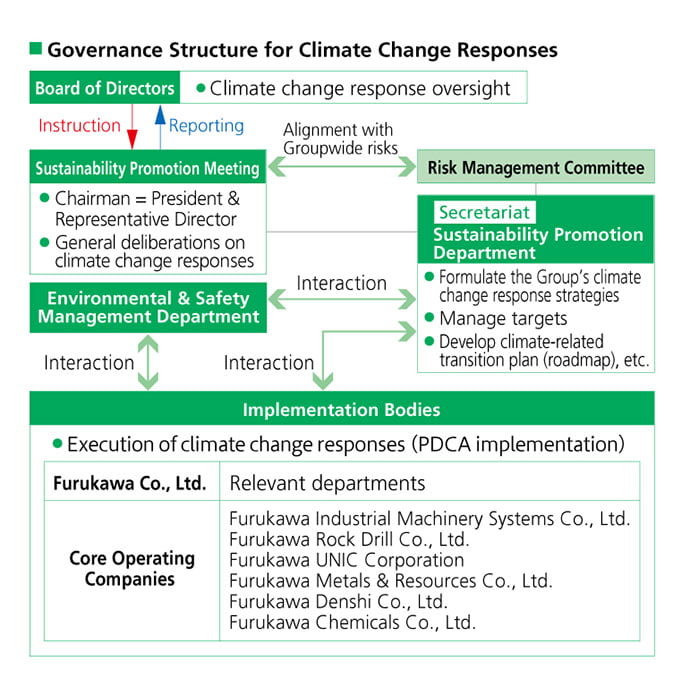Climate change
Climate change initiatives
The Furukawa Company Group recognizes that risks and opportunities associated with climate change represents an important management issue and is working to reduce greenhouse gas (GHG) emissions among other things.
The group expressed its support for the recommendations of the Task Force on Climate-related Financial Disclosures (TCFD) and participate in the TCFD Consortium in August 2023.


Information Disclosure Based on TCFD Recommendations
The TCFD recommends that information be disclosed in accordance with four core disclosure elements: Governance, Strategy, Risk Management, and Metrics and Targets. The Group will work to further enhance disclosure based on these four elements.
Governance
The Sustainability Promotion Meeting, chaired by the President and Representative Director, deliberates on how to address issues related to climate change and reports details of its deliberations to the Board of Directors.
The Sustainability Promotion Meeting discusses various matters related to climate change. These include formulation of basic policies and action plans for the Group’s climate change responses, development of a promotion framework, verification and evaluation of the status of activities, and education and public relations measures, and so on. In addition to Company directors and the presidents of each core operating companies, the Meeting includes the chairman of the Environmental & Safety Management Committee (general manager of the Environmental & Safety Management Department) and the general manager of the Sustainability Promotion Department. The Sustainability Promotion Department and the Environmental & Safety Management Department formulate the Group’s climate change response strategies, manage targets, and develop a climate-related transition plan (roadmap) based on deliberations and suggestions made by the Meeting. Those departments also work together with the implementation bodies (the Group companies and every company department) to develop a PDCA cycle of planning, execution, evaluation, and improvement.
Implementation of climate change responses by the Group companies and every company department is subject to institutional decisions by the Company’s Management Council, Board of Directors, and others according to the level of importance. The director in charge of the Sustainability Promotion Department reports on the progress and results of climate change responses to the Board of Directors from time to time, thereby providing proper oversight by the Board.
Governance Structure for Climate Change Response

| Organizations and Meeting Bodies and Their Roles |
|---|
| Board of Directors |
|
| Sustainability Promotion Meeting |
|
| Sustainability Promotion Department Environmental & Safety Management Department |
|
| Relevant departments of Furukawa Co., Ltd. Core operating companies |
|
Strategy
The Group operates numerous businesses and recognizes that the risks and opportunities associated with climate change vary from business to business. With this in mind, we previously conducted scenario analyses of the Rock Drill Machinery segment and Metals segment from two perspectives: the impact of climate change and the scale of business sales. In fiscal 2023, we conducted similar analyses of the UNIC Machinery segment and Chemicals segment. For the scenario analyses, we set 1.5˚C and 4˚C scenarios based on scientific evidence from the International Energy Agency (IEA) and other sources. We then evaluated the significance of climaterelated risks and opportunities that could affect our business in 2030 (interim) and 2050 (long term).
Going forward, we will conduct scenario analyses of the remaining segments while continuously reviewing the analyses already conducted.
| Set Scenarios | Worldview |
|---|---|
| 1.5˚C Scenario Emergence of transition risks and opportunities ⇒ 2030 assumption |
|
| 4˚C Scenario Emergence of physical risks and opportunities ⇒ 2050 assumption |
|
Lists of risks and opportunities
Below are the risks and opportunities we have identified that have a “medium” or larger level of impact on our business.
<Degree of impact>
Large: Major impact on the Company group
Medium: Limited impact on the Company group
Small: Minimal impact on the Company group
| Type of Risk | Risk Description | Segment | Impact | Countermeasures | Segment | |||
|---|---|---|---|---|---|---|---|---|
| 1.5℃ | 4℃ | |||||||
| Medium term | Long term | |||||||
| Risk | Transition risk | Government policies/regulations | Introduction of a carbon tax will increase transportation and other fuel procurement costs, as well as production costs and operational costs (GHG response costs related to electricity and delivery). | Rock Drill Machinery, UNIC Machinery, Metals, Chemicals | Medium | Small | Switch to renewable energy, save energy, and reduce the environmental impact of our products | |
|
Rock Drill Machinery, UNIC Machinery, Metals, Chemicals | |||||||
|
Rock Drill Machinery, Chemicals | |||||||
|
Rock Drill Machinery | |||||||
|
UNIC Machinery | |||||||
|
Chemicals | |||||||
| Technology | Failure to meet needs of the market, which favors products with low environmental impact, will result in lower sales. | Rock Drill Machinery, UNIC Machinery | Medium | Small |
|
Rock Drill Machinery | ||
| Physical risk | Acute | Extreme weather events (such as floods) may cause shutdowns at business sites or factories, leading to a decrease in sales and an increase in recovery costs. Additionally, supply chain instability can result in higher operating costs, delayed deliveries, and potential damage to our reputation. | Rock Drill Machinery, UNIC Machinery, Metals, Chemicals | Small | Large | Minimize damage and ensure proper management when disaster strikes | ||
|
Rock Drill Machinery, UNIC Machinery, Metals, Chemicals | |||||||
| Extreme weather conditions may lead to increased air conditioning costs, reduced productivity, and a rise in health risks for employees working outdoors. | UNIC Machinery | Small | Medium |
|
UNIC Machinery | |||
| Type of Opportunity | Opportunity Description | Segment | Impact | Countermeasures | Segment | ||
|---|---|---|---|---|---|---|---|
| 1.5℃ | 4℃ | ||||||
| Medium term | Long term | ||||||
| Opportunity | Market | Rising demand for machines that contribute to decarbonization will help bolster sales. | Rock Drill Machinery | Medium | Small |
|
Rock Drill Machinery |
| Reconstruction projects after disasters caused by extreme weather events will generate demand for our products | Rock Drill Machinery, UNIC Machinery | Small | Large |
|
Rock Drill Machinery | ||
|
UNIC Machinery | ||||||
| Technology | Sales of products that contribute to energy conservation will increase. | Rock Drill Machinery, UNIC Machinery | Medium | Small |
|
Rock Drill Machinery | |
|
UNIC Machinery | ||||||
| Timely responses to customer requests and technical support to address specification changes related to the shift to EVs will help bolster sales. | UNIC Machinery | Medium | Small |
|
UNIC Machinery | ||
Risk Management
Assessment of climate-related risks and consideration of countermeasures are conducted by the Risk Management Committee, which comprehensively deliberates important matters related to Groupwide risk management. The Committee is chaired by the director in charge of sustainability of the Company, and the Sustainability Promotion Department serves as its secretariat. The Committee meets twice a year in principle. Its members are selected from every Company departments and core operating companies. Together with the secretariat, the members assess climate-related risks affecting the Group, consider and formulate countermeasures, and report the results to the Board of Directors, thereby proper oversight is provided by the Board.
Metrics and Targets
In fiscal 2023, we expanded the scope of calculation of CO2 emis- sions, from major domestic production operations to a consolidat- ed basis, including overseas sites. Accordingly, on July 30, 2024, we announced our new CO2 emission reduction targets, using fiscal 2023 as the benchmark year. In line with the Paris Agree- ment and the targets set by the Japanese government, the Group aims to reduce Scope 1 (energy origin) and 2 emissions by 25% compared with fiscal 2023 by 2030 and achieve carbon neutrality by 2050.
Data
Third party verification certificate
To enhance the reliability of its environmental data, the Furukawa Company Group obtained independent third-party verification for its fiscal 2024 CO2 emissions (Scope 1 and Scope 2).
